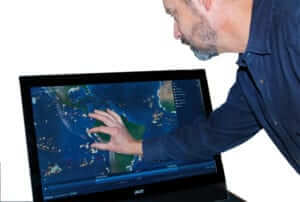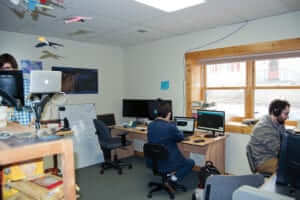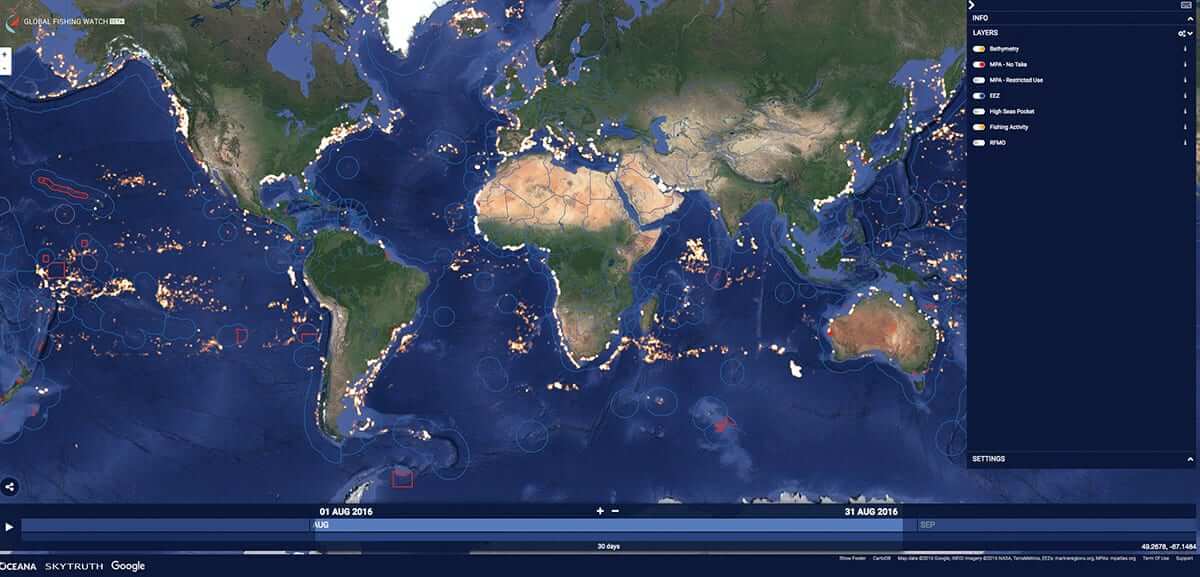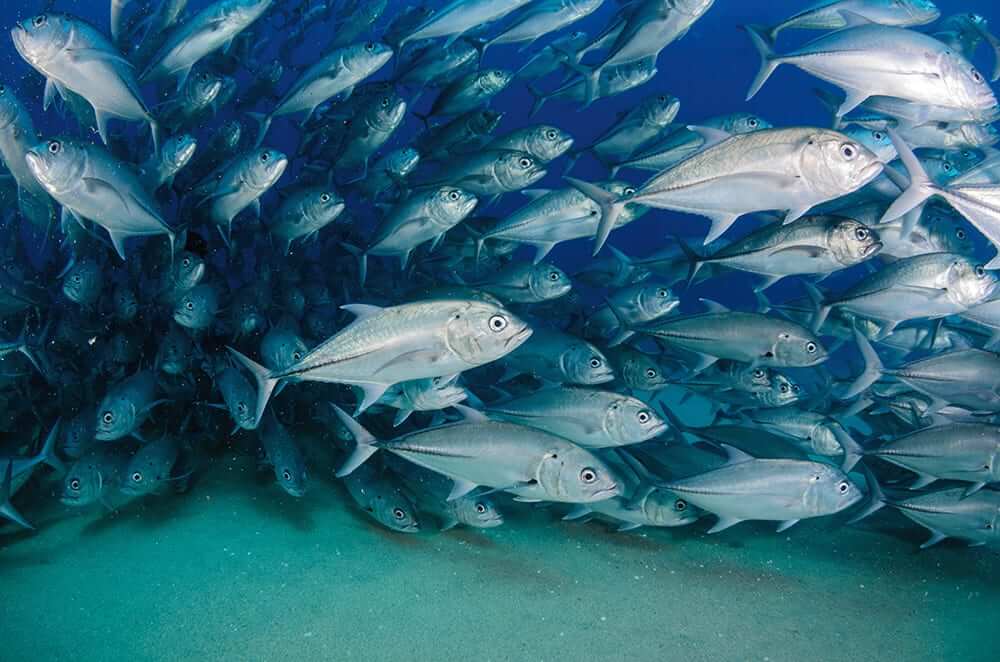From an unassuming office in a tiny West Virginia town, SkyTruth helps us watch what’s happening in the places we want to protect, all around the world.

“They called us and said, ‘You have more granular data than we do. Can you show us the track of the vessel?’” says John Amos, president of SkyTruth, in Shepherdstown. SkyTruth’s reconstruction showed the ship had moved in circles—the classic signature of purse seine fishing, which encircles schools of fish with nets. Confronted with that, the captain couldn’t argue. He owned up and paid Kiribati a fine of $1.2 million, almost one percent of the tiny nation’s gross domestic product. “Hopefully that can pay for some management and enforcement assets,” Amos says.
It’s a surprising role for a small West Virginia nonprofit organization to play. Amos enjoys contrasting his group of 15 with its partners in this worldwide vessel-tracking endeavor. “Oceana is the world’s biggest ocean conservation organization. Google, of course, is Google,” he quips. “And then there’s us. Little old SkyTruth. We are the designers and builders in this partnership of a tool called Global Fishing Watch.”
Demonstrated in prototype in November 2014 and publicly launched at the offices of the U.S. Department of State in September 2016, Global Fishing Watch (GFW) is the biggest way SkyTruth has found yet to leverage satellite imagery and data in service of grassroots environmental stewardship.
Truth from the sky
As a geologist working for oil and gas and mining companies in the 1990s, Amos had access to satellite imagery few people got to see. Some of what he saw disturbed him.
“I thought, ‘Gosh, I had no idea there was pollution like this happening out in the ocean,’ and, ‘I had no idea that these forests were being cut down in Siberia at such a tremendous rate,’” he recalls. “The human impact on the planet was obvious in those images. I started thinking it shouldn’t be just me seeing this—anybody who cares should have access to these images and see with their own eyes what’s going on.”
He started SkyTruth in 2001, just as ever-increasing volumes of satellite imagery started to become available. Based mainly out of a few quiet, spartan back rooms in Shepherdstown with far more screens than people, SkyTruth has publicized images of the environmental effects of surface mining, gas drilling and flaring, and other large-scale industrial operations that can be hard for regulators and the public to monitor. Citizens’ groups, media organizations, and governments around the world have relied on SkyTruth’s tools and analyses. The organization drew international media attention in 2010 when it called official estimates of the size of the BP Deepwater Horizon oil spill in the Gulf of Mexico into question.
Large, stationary environmental effects have been visible by satellite for a while. But in the past few years, better imagery, data, and processing power have made it possible to observe small mobile targets—like individual fishing vessels on the high seas.

Global ocean fish harvest started plateauing in the 1980s. With world population continuing to rise, everyone from hunger-concerned nonprofits to the United Nations has been trying to figure out how to monitor the ocean’s fisheries and limit their harvest to sustainable levels.
Regulating the ocean is hard. About two-thirds of it lies beyond the 200-mile marine zone each coastal country controls off its shores—meaning almost half of the planet is the Wild, Watery West. International efforts are gradually boosting respect for harvest limits, reporting accuracy, and commitment to refusing harvest that isn’t clearly legal and documented. But pirate fishers continue to elude regulators.
“A lot of overfishing and illegal fishing are aided by the ability of fishing vessels to spend many months at sea without coming into port, where they’d be inspected,” Amos explains. “The way they do that is, they rendezvous with refrigerated cargo vessels and offload their catch and then resume fishing.” It’s called “transshipment.” These large refrigerated vessels—“reefers”—deliver their loads in ports where officials look the other way, allowing them to introduce undocumented catch into the seafood supply chain. At least 15 percent of the annual catch is undocumented, according to the most recent UN estimate—a volume that threatens the viability of ocean fisheries and undermines future food security.
To crack down on pirate fishers, observers need to see their tell-tale movements on the high seas. That’s where Global Fishing Watch comes in. GFW tracks the activities of some 35,000 fishing vessels so far, an estimated half of the industrial high seas fishing fleet, through the pings their transceivers send every few minutes. It combines multiple datasets to identify the vessels, and it plots the vessels’ locations and paths on a highly interactive online map that also shows national and other jurisdictions on the oceans.
But locations and paths don’t tell the whole story. The real power of GFW lies in analysis of the data. Using algorithms SkyTruth has developed to identify the characteristic movements ships make when their fishing gear is in the water, GFW drops markers on the map where direction and speed changes indicate apparent fishing activity. And in February 2017, SkyTruth and GFW released a first-time report on transshipment. The analysis followed almost 800 reefers, estimated to be more than 90 percent of the total, and found more than 5,000 likely and 86,000 potential transshipping incidents from 2012 through 2016. It also revealed which flags and ports are most associated with transshipment.
GFW is quickly becoming a go-to resource. Within a few weeks of last September’s launch—an event that featured then-U.S. Secretary of State John Kerry and funder Leonardo DiCaprio—20,000 users had signed on to the free tool. Users come mainly from the U.S. and international governments as well as treaty-based regional fishing management organizations, the media, and non-governmental conservation organizations (NGOs). “I just got a great comment from Greenpeace, unsolicited, saying that their team that works on fisheries had just attended a webinar on how to use Global Fishing Watch,” Amos said in early March. “They were really enthusiastic and said that it is rapidly becoming ‘the’ platform to use for fisheries-related work by NGOs.”
Ocean fish harvest has dropped off as much as 10 percent from its 1980s and ’90s plateau. SkyTruth’s experience with GFW underlines actions regulators could take to help fisheries rebound. Beyond simply tracking down rogue operators and port officials, they could work to require more ships to use transceivers, Amos says, and to establish unique vessel IDs that would prevent operators from hiding behind changes of name and flag.
Looking ahead
Because of GFW’s success, its founding partners are working toward setting it up as an independent nonprofit organization this year, Amos says. SkyTruth expects to remain closely involved.
But the organization is never at a loss for projects. On the model of its successful crowdsourced FrackFinder mapping projects in Pennsylvania and Ohio, SkyTruth plans to launch FrackFinder West Virginia in summer 2017 to engage citizen scientists in identifying hydraulic fracturing sites on high-resolution images. It’s an approach that multiplies SkyTruth’s productivity, Amos says, while educating residents about activities that affect their communities. And because image availability is continually improving, SkyTruth is revisiting an analysis it did in 2007 of Southern Appalachian surface mining in 1975, 1985, 1995, and 2005 by filling in with annual data. The past study informed others’ research and Amos hopes the update will be used similarly—to estimate the need for site reclamation, he suggests by way of example.
SkyTruth leverages the best assets of its small-town setting to do its world-changing work. “Shepherdstown punches above its weight class in a number of categories, one of which is the number of really smart, engaged, interesting people who are here,” Amos says—people who have become informal advisers and board members for SkyTruth. At the same time, much of his small staff telecommutes from two other continents and three other states. “I think that is reflective of the ultimate vision of SkyTruth,” he says, “that anyone anywhere can access the same tools and data and technology that we’re using to better understand their local issues.”













Leave a Reply